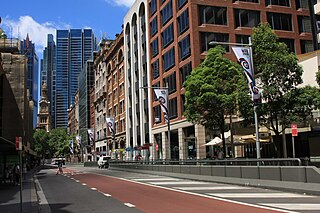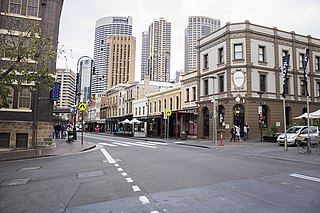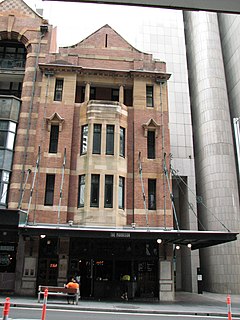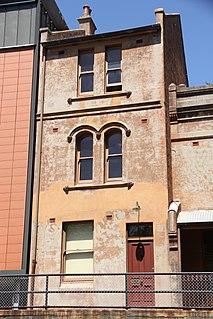
Pitt Street is a major street in the Sydney central business district in New South Wales, Australia. The street runs through the entire city centre from Circular Quay in the north to Waterloo, although today's street is in two disjointed sections after a substantial stretch of it was removed to make way for Sydney's Central railway station. Pitt Street is well known for the pedestrian only retail centre of Pitt Street Mall, a section of the street which runs from King Street to Market Street.

The Sydney Central Business District (CBD) is the historical centre and the main commercial centre of Sydney, located on iconic Sydney Harbour. The Sydney CBD is Sydney's city centre, or Sydney City, and the two terms are used interchangeably. The CBD or city centre is often referred to simply as "Town" or "the City". The Sydney city centre extends southwards for about 3 km (2 mi) from Sydney Cove, the point of first European settlement in which the Sydney region was initially established. Due to its pivotal role in Australia's early history, it is one of the oldest established areas in the country.
Australian non-residential architectural styles are a set of Australian architectural styles that apply to buildings used for purposes other than residence and have been around only since the first colonial government buildings of early European settlement of Australia in 1788.

Hong Kong House, also known since 1995 as the Hong Kong Economic and Trade Office, Sydney, is a landmark heritage building and former hotel in the Sydney central business district, City of Sydney, New South Wales, Australia. Built in 1891 to a design by Ambrose Thornley, it is located on 80 Druitt Street, at the corner with York Street, and is adjacent to other prominent heritage landmarks, the Sydney Town Hall and the Queen Victoria Building. Formerly known as Gresham Hotel, the property was added to the New South Wales State Heritage Register on 2 April 1999.

Bridge Street is a street in the central business district of Sydney in New South Wales, Australia. Bridge Street runs for 500 metres (1,600 ft) in a west–east direction with traffic flowing in both directions. It is situated in the northern portion of the central business district. The western terminus of Bridge Street is at George Street, with the eastern terminus at Macquarie Street, adjacent to the Chief Secretary's Building. From west to east, Bridge Street crosses Pitt and Phillip streets.

York Street is a street in the Sydney central business district in New South Wales, Australia. York Street runs 1.050 kilometres (0.652 mi) in a north to south direction only and is used predominantly by buses from the northern districts of Sydney.

The Talbragar Shire Council Chambers is a heritage-listed former council chambers and former bank building located in Macquarie Street, Dubbo, in the Dubbo Regional Council local government area of New South Wales, Australia. The building was designed by Architect Hilley. It is also known as CBC Bank and Commercial Banking Company. The property is owned by Dubbo Regional Council and was added to the New South Wales State Heritage Register on 2 April 1999.

The Tenterfield Post Office is a heritage-listed post office located at 225 Rouse Street, Tenterfield, Tenterfield Shire, New South Wales, Australia. It was designed by NSW Colonial Architect's Office under James Barnet and built from 1881 to by T. & J. McGuaran, later T. A. Lewis. It is also known as the Tenterfield Post Office and Quarters. The property is owned by Australia Post. It was added to the New South Wales State Heritage Register on 17 December 1999.

The Tamworth Post Office is a heritage-listed post office located at Fitzroy Street, Tamworth in the Tamworth Regional Council local government area of New South Wales, Australia. It was designed by the Colonial Architect's Office under James Barnet and built by W. C. Cains. The property is owned by Australia Post and was added to the New South Wales State Heritage Register on 22 December 2000.

Kempsey Post Office is a heritage-listed post office at Belgrave Street, Kempsey, Kempsey Shire, New South Wales, Australia. It was designed by the Colonial Architect's Office under James Barnet, and was built by Gabriel and McMorrine, with additions in 1903-04 built by Hocking Brothers. The property is owned by Australia Post. It was added to the New South Wales State Heritage Register on 22 December 2000.

The ASN Hotel Building is a heritage-listed commercial building and former pub and police station located at 91 George Street, in the inner city Sydney suburb of The Rocks in the City of Sydney local government area of New South Wales, Australia. It was built in 1839 and significantly rebuilt c. 1890-91. The property is owned by Property NSW. It was added to the New South Wales State Heritage Register on 10 May 2002.

The Brooklyn Hotel is a heritage-listed bar, restaurant and former hotel located at 229 George Street, in the suburb of The Rocks, in the city of Sydney, New South Wales, Australia. It was designed by Walter Liberty Vernon and built in 1912. The property is owned by Property NSW, an agency of the Government of New South Wales. It was added to the New South Wales State Heritage Register on 10 May 2002.

The Long's Lane Precinct, also Longs Lane Precinct, comprise a series of heritage-listed terrace houses located at 130 Cumberland Street, 132-134 Cumberland Street, 136-138 Cumberland Street, and 140-142 Cumberland Street, in the inner city Sydney suburb of The Rocks in the City of Sydney local government area of New South Wales, Australia. The terraces houses were built from 1888 to 1914. They are also known as 130 Cumberland Street; 132-134 Cumberland Street; 136-138 Cumberland Street; Watson's Butchery; and 140-142 Cumberland Street. The properties are owned by Property NSW, an agency of the Government of New South Wales. The precinct and the terrace houses were added to the New South Wales State Heritage Register on 10 May 2002.

47-53 Lower Fort Street, Millers Point are heritage-listed terrace houses located at 47-53 Lower Fort Street, in the inner city Sydney suburb of Millers Point in the City of Sydney local government area of New South Wales, Australia. The property was added to the New South Wales State Heritage Register on 2 April 1999.

Metropolitan Hotel is a heritage-listed hotel at 244 George Street, Sydney, Australia. It was added to the New South Wales State Heritage Register on 2 April 1999.

Sydney Water Head Office is a heritage-listed former office building, now the Primus Hotel Sydney, located in the Sydney central business district in New South Wales, Australia. The address of the building is 339–341 Pitt Street, Sydney, Australia. It was designed by Henry Budden & Mackey and built from 1938 to 1939 by Howie Moffat & Co. The building is also known as the Water Board Building and the Metropolitan Water, Sewerage and Drainage Board Headquarters. Following Sydney Water's relocation to Parramatta in 2009, it was adapted as a hotel called Primus Hotel, while the adjoining 1969 office building was extended as the Greenland Centre Sydney high-rise development. Primus Hotel Sydney is the first hotel outside China for the Primus Hotel chain owned by the Greenland Group, which itself is owned by the municipal government of Shanghai. It is also the first five-star hotel opened outside China by the Chinese government.

The Public Trust Office is a heritage-listed office building at 19–21 O'Connell Street, Sydney, Australia. It was designed by Ross & Rowe and built from 1926. It is also known as the Public Trustee. It was originally known as Rofe Chambers. It was added to the New South Wales State Heritage Register on 2 April 1999.

The Sydney Club is a heritage-listed club premises at 122 Pitt Street, in the Sydney central business district, in the City of Sydney local government area of New South Wales, Australia. It was designed by Mansfield Brothers and built from 1886 to 1887 by A & A Scott. It is also known as Million House. It was added to the New South Wales State Heritage Register on 2 April 1999.

Grahame's Corner is a heritage-listed commercial and office building located at 142-144 Pitt Street, in the Sydney central business district, in the City of Sydney local government area of New South Wales, Australia. It was designed by G. A. Morell and built from 1877 to 1882. It is also known as Grahams Corner and the AMFIS Building. The property was added to the New South Wales State Heritage Register on 2 April 1999.

181-187 Hay Street is a heritage-listed former council chambers located at 181-187 Hay Street, in the Sydney central business district, in the City of Sydney local government area of New South Wales, Australia. It was built from 1893. It is also known as the Municipal Building and the Corporation Building. The property is owned by City of Sydney and was added to the New South Wales State Heritage Register on 2 April 1999.




















